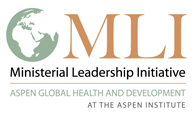 This is the third in a series of blogs from the Ministerial Leadership Initiative for Global Health's Learning Collaborative Forum held in Addis Ababa, Ethiopia.
This is the third in a series of blogs from the Ministerial Leadership Initiative for Global Health's Learning Collaborative Forum held in Addis Ababa, Ethiopia.
For years, Mali has had community-funded health insurance organizations, but the movement grew slowly. At the end of 2009, the country’s120 so-called mutuelles provided coverage to just 2.1 percent of the population.
Dr. Salif Samake, director of planning and statistics at Mali’s Ministry of Health, told the MLI Learning Collaborative Forum today in Addis Ababa, Ethiopia, that his government was committed to a universal health coverage plan that would expand the health insurance service to 351 communities, with 28.4 percent of the country’s residents in the next five years.
In a free-wheeling session afterward, Samake’s peers in Health Ministries in Ethiopia, Nepal, Sierra Leone and Senegal – many of whom also are wrestling with health financing and equitable coverage -- then gave him a series of challenging questions.
Pour lire la version française, voir ci-dessous.
For years, Mali has had community-funded health insurance organizations, but the movement grew slowly. At the end of 2009, the country’s120 so-called mutuelles provided coverage to just 2.1 percent of the population.
Dr. Salif Samake, director of planning and statistics at Mali’s Ministry of Health, told the MLI Learning Collaborative Forum today in Addis Ababa, Ethiopia, that his government was committed to a universal health coverage plan that would expand the health insurance service to 351 communities, with 28.4 percent of the country’s residents in the next five years.
In a free-wheeling session afterward, Samake’s peers in Health Ministries in Ethiopia, Nepal, Sierra Leone and Senegal – many of whom also are wrestling with health financing and equitable coverage -- then gave him a series of challenging questions:
READ MORE »

 This is the fourth in a series of interviews with participants at the Ministerial Leadership Initiative for Global Health’s Learning Collaborative Forum in Addis Ababa on motivation – what motivates them and how do they motivate others. Dr. Issa Bara Berthe, 36, is the chief of statistics and information division at the Ministry of Health in Mali.
This is the fourth in a series of interviews with participants at the Ministerial Leadership Initiative for Global Health’s Learning Collaborative Forum in Addis Ababa on motivation – what motivates them and how do they motivate others. Dr. Issa Bara Berthe, 36, is the chief of statistics and information division at the Ministry of Health in Mali. This is the ninth in a series of posts from the Ministerial Leadership Initiative's Learning Collaborative Forum in Ethiopia.
This is the ninth in a series of posts from the Ministerial Leadership Initiative's Learning Collaborative Forum in Ethiopia. This is the sixth in a series of posts from the Ministerial Leadership Initiative's
This is the sixth in a series of posts from the Ministerial Leadership Initiative's  This is the third in a series of blogs from the Ministerial Leadership Initiative for Global Health's
This is the third in a series of blogs from the Ministerial Leadership Initiative for Global Health's  John Donnelly will be live blogging this week from the Ministerial Leadership Initiative for Global Health's
John Donnelly will be live blogging this week from the Ministerial Leadership Initiative for Global Health's